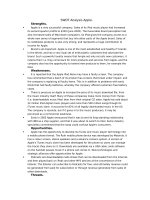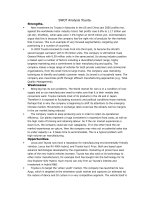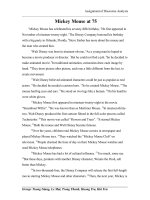intermarket analysis john murphy
Bạn đang xem bản rút gọn của tài liệu. Xem và tải ngay bản đầy đủ của tài liệu tại đây (3.61 MB, 290 trang )
ffirs.qxd 10/31/03 12:31 PM Page iii
Intermarket
Analysis
Profiting from
Global Market Relationships
JOHN MURPHY
John Wiley & Sons, Inc.
ffirs.qxd 10/31/03 12:31 PM Page iii
ffirs.qxd 10/31/03 12:31 PM Page i
Intermarket
Analysis
ffirs.qxd 10/31/03 12:31 PM Page ii
Founded in 1807, John Wiley & Sons is the oldest independent publishing
company in the United States. With offices in North America, Europe, Australia, and Asia, Wiley is globally committed to developing and marketing
print and electronic products and services for our customers’ professional
and personal knowledge and understanding.
The Wiley Trading series features books by traders who have survived
the market’s ever changing temperament and have prospered—some by reinventing systems, others by getting back to basics. Whether a novice trader,
professional or somewhere in-between, these books will provide the advice
and strategies needed to prosper today and well into the future.
For a list of available titles, please visit our Web site at www.WileyFinance.com.
ffirs.qxd 10/31/03 12:31 PM Page iii
Intermarket
Analysis
Profiting from
Global Market Relationships
JOHN MURPHY
John Wiley & Sons, Inc.
ffirs.qxd 10/31/03 12:31 PM Page iv
Copyright © 2004 by John Murphy. All rights reserved.
Some of the figures in Chapters 1, 2, and 3 were created by Knight Ridder’s Tradecenter.
Tradecenter is a registered trademark of Knight Ridder’s Financial Information.
Published by John Wiley & Sons, Inc., Hoboken, New Jersey.
Published simultaneously in Canada.
No part of this publication may be reproduced, stored in a retrieval system, or transmitted in any form or by any means, electronic, mechanical, photocopying, recording, scanning, or otherwise, except as permitted under Section 107 or 108 of the 1976 United States
Copyright Act, without either the prior written permission of the Publisher, or authorization through payment of the appropriate per-copy fee to the Copyright Clearance Center,
Inc., 222 Rosewood Drive, Danvers, MA 01923, 978-750-8400, fax 978-646-8600, or on
the web at www.copyright.com. Requests to the Publisher for permission should be
addressed to the Permissions Department, John Wiley & Sons, Inc., 111 River Street,
Hoboken, NJ 07030, 201-748-6011, fax 201-748-6008, e-mail:
Limit of Liability/Disclaimer of Warranty: While the publisher and author have used their
best efforts in preparing this book, they make no representations or warranties with
respect to the accuracy or completeness of the contents of this book and specifically disclaim any implied warranties of merchantability or fitness for a particular purpose. No
warranty may be created or extended by sales representatives or written sales materials.
The advice and strategies contained herein may not be suitable for your situation. You
should consult with a professional where appropriate. Neither the publisher nor author
shall be liable for any loss of profit or any other commercial damages, including but not
limited to special, incidental, consequential, or other damages.
For general information on our other products and services, or technical support, please
contact our Customer Care Department within the United States at 800-762-2974, outside
the United States at 317-572-3993 or fax 317-572-4002.
Wiley also publishes its books in a variety of electronic formats. Some content that
appears in print may not be available in electronic books.
For more information about Wiley products, visit our web site at www.wiley.com.
ISBN: 0-471-02329-9
Printed in the United States of America.
10 9 8 7 6 5 4 3 2 1
ffirs.qxd 10/31/03 12:31 PM Page v
To Anne, a great poet
and
to Tim, a great brother
ffirs.qxd 10/31/03 12:31 PM Page vi
ftoc.qxd 10/31/03 12:35 PM Page vii
Contents
Acknowledgments
ix
Introduction to Intermarket Analysis
xi
1. A Review of the 1980s
1
2. 1990 and the First Persian Gulf War
17
3. The Stealth Bear Market of 1994
33
4. The 1997 Asian Currency Crisis and Deflation
51
5. 1999 Intermarket Trends Leading to Market Top
65
6. Review of Intermarket Principles
81
7. The NASDAQ Bubble Bursts in 2000
97
8. Intermarket Picture in Spring 2003
115
9. Falling Dollar During 2002 Boosts Commodities
131
10. Shifting from Paper to Hard Assets
145
11. Futures Markets and Asset Allocation
159
12. Intermarket Analysis and the Business Cycle
179
13. The Impact of the Business Cycle on Market Sectors
199
14. Diversifying with Real Estate
217
15. Thinking Globally
235
Appendix
247
Index
263
vii
ftoc.qxd 10/31/03 12:35 PM Page viii
flast.qxd 10/31/03 12:33 PM Page ix
Acknowledgments
owe thanks to a lot of people who helped put this book together: Pamela
van Giessen, Executive Editor at Wiley, for talking me into doing it in the
first place; Jennifer MacDonald and Joanna Pomeranz for making sure
that everything wound up in the right place; Heidi Shelton and Pete Behmer
at Stockcharts.com for producing great looking charts; John Carder at
Topline Investment Graphics for his innovative historical charts; Tim Murphy
for his help with the cover design and computer graphics; those market analysts who generously allowed me to draw from their work including Ned
Davis, Ken Fisher, Ian Gordon, Martin Pring, and Sam Stovall. And, finally,
the McTooles family who kept my spirits up while I was writing this book.
I
ix
flast.qxd 10/31/03 12:33 PM Page x
flast.qxd 10/31/03 12:33 PM Page xi
Introduction
to Intermarket
Analysis
n 1990, I completed a book entitled Intermarket Technical Analysis:
Trading Strategies for the Global Stock, Bond, Commodity, and Currency Markets. My point in writing it was to show how closely related all
the financial markets really are, both domestically and internationally. The
book’s main thesis was that technical analysts need to broaden their chart
focus to take these intermarket correlations into consideration. Analysis of
the stock market, for example, without consideration of existing trends in the
dollar, bond, and commodity markets was simply incomplete. The book suggested that financial markets can be used as leading indicators of other markets and, at times, confirming indicators of related markets. Because the
message of my earlier text challenged the single market focus of the technical community, some questioned whether this newer approach had any place
in the technical field. Many questioned whether intermarket relationships
existed at all—and whether they could be used in the forecasting process. The
idea that global markets are linked to each other was also viewed with some
skepticism. How things have changed in just one decade.
Intermarket analysis is now considered a branch of technical analysis and
is becoming increasingly popular. The Journal of Technical Analysis (Summer–
Autumn 2002) asked the membership of the Market Technicians Association to
rate the relative importance of technical disciplines for an academic course on
technical analysis. Of the fourteen disciplines included in the poll, intermarket
analysis ranked fifth. Intermarket work has come a long way in ten years.
I
EARLIER BOOK COVERED THE 1980s
My earlier text focused on events in the 1980s starting with the end of the
commodity bubble at the start of that decade. This ended the hyperinflation of
xi
flast.qxd 10/31/03 12:33 PM Page xii
xii
INTRODUCTION
the 1970s when hard assets like commodities soared and paper assets (like
bonds and stocks) soured. The 1980 peak in commodities ushered in a twodecade disinflationary trend that coincided with major bull markets in bonds
and stocks. The biggest financial event of the 1980s—the 1987 stock market
crash—provided a textbook example of how markets are related to each
other and the necessity for paying attention to those related markets. A surge
in commodity prices—and a collapse in bond prices—during the first half of
1987 gave ample warning of an impending stock market decline during that
year’s second half. Three years later during 1990, as the previous book was
going to press, global financial markets were just starting to react to Iraq’s
invasion of Kuwait in August of that year. Gold and oil prices surged—while
stock markets around the world fell. Interestingly, thirteen years later (at the
start of 2003), market observers were facing the prospect of another Iraq war
and were studying anew the 1990–1991 market reactions to look for parallels.
History has a way of repeating itself, even in intermarket work.
JAPANESE BUBBLE BURSTS IN 1990
Another important event which happened at the start of 1990 is still having
global repercussions more than a decade later. The bubble in the Japanese
stock market burst. This started a thirteen-year descent in that market (which
represented the world’s second largest economy) that turned into a deflation (a decline in the prices of goods and services). Over a decade later, western central bankers were studying the Japanese deflation model to find ways
to combat increasing signs of deflation in western economies. Some of the
charts presented in this book also bolster the view that Japanese deflation
was one of the major contributing factors to the decoupling of bonds and
stocks in the United States years later when rising bond prices starting in
2000 coincided with falling stock prices.
THIRD ANNIVERSARY OF 2000 MARKET TOP
March 10, 2003 marked the third anniversary of the ending of the Nasdaq
bubble that signaled the start of the worst bear market in decades. A 50 percent decline in the S&P 500 was the worst since 1974. The Nasdaq’s loss of 78
percent was the worst since the stock market crash from 1929–1932 in the
midst of the Great Depression. Market historians had to go back to study
flast.qxd 10/31/03 12:33 PM Page xiii
Introduction
xiii
these two periods to gain some insight into market behavior. What made
comparisons between these two earlier periods complicated was that each of
them was caused by a different economic event. The bear market in stocks
during the 1970s was associated with a period of rising commodity prices—
and hyperinflation. The bear market of the 1930s, however, was associated
with a period of economic deflation. While both situations are bad for stocks,
deflation is the more difficult to counter.
Starting in 1998, the word deflation was being heard for the first time
since the 1930s. This happened as a result of the Asian currency crisis that
gripped the world during 1997 and 1998. Within five years, global deflation
had spread from Asia and was starting to infect global bond and stock markets everywhere—including the United States. More than any other factor,
the reappearance of deflation changed intermarket relationships that had
existed over the prior forty years. These changes are why I am writing this
book—to show what has worked according to the older intermarket model
and, more importantly, what has changed. Intermarket analysis is based on
relationships (or correlations) between markets. It is not, however, a static
model. Correlations between financial markets can change over time. They
do not change randomly, however; there is usually a good reason. The main
reason for some of the changes that started in the late 1990s was the growing
threat of deflation.
THE DEFLATION SCENARIO
In the 1999 revision of my book Technical Analysis of the Financial Markets, I included a chapter on intermarket analysis which reviewed the historic
relationships that had been working for several decades. I also added a new
section which was entitled “Deflation Scenario.” This section described the
collapse in Asian currency and stock markets starting in the middle of 1997;
the severe decline had an especially depressing effect on global commodity
markets like copper, gold, and oil. For the first time in generations, analysts
starting expressing concern that a beneficial era of disinflation (when prices
are rising at a slower rate) might turn into a harmful deflation (when prices of
goods actually fall). How the markets reacted to that initial threat of deflation
defined the intermarket model for the next five years. Commodity prices fell
while bond prices rose. This was nothing new—falling commodity prices
usually produce higher bond prices. What changed, though, was the relationship between bonds and stocks. During 1998, stocks were sold all over the
world while money poured into U.S. Treasury bonds in a global search for
flast.qxd 10/31/03 12:33 PM Page xiv
xiv
INTRODUCTION
safety. In other words, stocks fell while bonds rose. This was unusual and
represented the biggest change in the intermarket model. Disinflation (which
lasted from 1981 through 1997) is bad for commodities but is good for bonds
and stocks. Deflation (which started in 1998) is good for bonds and bad for
commodities—but is also bad for stocks. In a deflationary climate, bond
prices rise while interest rates fall. Falling interest rates, however, do not
help stocks. This explains why a dozen easings by the Federal Reserve in the
eighteen months after January 2001 were unable to stop a falling stock market that had peaked at the start of 2000.
INTERMARKET MODEL FROM 1980 TO 1997
This book begins with a quick review of the 1980s, starting with the big intermarket changes that helped launch the greatest stock bull market in history.
We will also revisit the 1987 stock market crash—because of its importance in
the development of intermarket theory and its role in changing this theory into
reality. The 1990 bear market was just starting as I was completing my earlier
book. We will study this year in more depth, especially given its relevance to
global events thirteen years later. Traditional intermarket relationships held
up quite well during the 1994 bear market and continued to do so until 1998.
THEN CAME 1998 AND THINGS CHANGED
The rest of this book deals with market events from 1998 onwards. That year
represented a sea change in the intermarket model. We will study market
forces leading up to the bursting of the stock market bubble in the spring of
2000—and the ensuing three years of stock market decline. Deflation plays a
key role from 1998 on. Global markets became very closely correlated during
the late 1990s and the first three years of the new millennium. This was
mainly due to global overinvestment in technology stocks during the latter
stages of the Nasdaq bubble—and the ensuing global collapse after the bubble burst. Deflationary trends were also global in scope. The fact that virtually all world markets collapsed together after 2000 called into question the
wisdom of global diversification (when stock investments are made in foreign markets to reduce overall risk). During global bear markets in stocks, all
world markets become closely correlated to the downside. This happened
during the crash of 1987—and again after 2000. It was also another manifes-
flast.qxd 10/31/03 12:33 PM Page xv
Introduction
xv
tation of the intermarket reality that financial trends are usually global in
nature. This includes the direction of stock markets, interest rates, currency
markets, and trends in inflation and deflation.
THE ROLE OF OIL
In 1999, rising oil prices set in motion a series of events that led to the start
of a bear market in stocks in the spring of 2000 and the onset of a recession
a year later in the spring of 2001. Rising oil prices have contributed to virtually every U.S. recession in the last forty years. 1999 was no exception. The
surge in oil prices led the Federal Reserve to tighten interest rates, which
helped end the longest economic expansion since the 1960s. This action by
the Fed led to an inverted yield curve as 2000 started; this is a classic warning sign of stock market weakness and impending recession. All of these
trends were clearly visible on the price charts at the time, a fact which is
demonstrated in the book. Unfortunately, the economic community—
together with most Wall Street analysts—either did not see the classic warning signs of trouble or simply chose to ignore them.
Another change from my previous book is the increasingly important
role that sector rotation plays in intermarket work. Different stock market
sectors take over market leadership at different points in the economic cycle.
In 1999, oil stocks were the market’s strongest sector. This is usually a bad
sign for the economy and the stock market. You will see how valuable sector
“signals” were during the crucial years of 1999 and 2000—and how some
defensive market sectors started new uptrends just as the Nasdaq peaked.
THE RESURGENCE OF GOLD
During the twenty years from 1980 to 2000, gold was in a major downtrend.
This was due to the disinflationary trend of that two-decade period and to the
fact that gold generally does poorly during bull markets in stocks. Because
gold is bought mainly during times of crisis, there is not much need for it during a super bull market in stocks. A strong dollar during most of those years
also kept gold out of favor. This started to change in 2000, however. During
that watershed year, the twenty-year bull market in stocks came to an end. At
the same time, a seven-year bull market in the U.S. dollar was ending. These
two factors combined to light a fire under a moribund gold market. Over the
flast.qxd 10/31/03 12:33 PM Page xvi
xvi
INTRODUCTION
next three years, gold stocks were the top-performing stock market sector.
Interestingly, the gold rally started in 2000—right around the time that deflationary talk started to get louder. This puzzled investors, who believed that
gold could only be used as an inflation hedge. History shows that gold stocks
did very well in the deflationary climate of the 1930s. Gold’s historic role has
been as a store of value during times of economic upheaval. Another reason
for gold’s popularity in deflationary times is the Federal Reserve’s attempt to
reflate the economy. It does this by weakening the dollar in an attempt to create a little inflation, which in turn boosts the price of gold. The Fed tried this
in the 1930s and in its more recent battle against deflation in the early 2000s.
The strategy worked during the 1930s and appears to be working again seventy years later.
ASSET ALLOCATION AND ECONOMIC FORECASTING
Intermarket work has important applications in the areas of asset allocation
and economic forecasting. It has long been accepted that the stock market is
a leading indicator of the economy. A classic example of this occurred when
the U.S. market peaked in March of 2000. It took the economic world twelve
months—until March of 2001—to officially declare that a U.S. recession had
started. Markets have a way of looking into the future to “discount” economic trends as far away as six months. This is true for all, including the dollar, bonds, and commodities markets. Commodities give us an early warning
of deflationary or inflationary trends. The dollar does the same. The direction
of bonds tells us whether interest rates are rising or falling—which tells us a
lot about the strength or weakness of the economy. And all of these trends
subsequently affect the direction of the economy and the stock market.
More importantly, intermarket work helps us to determine which part of
the financial spectrum offers the best hope for potential profits. From 2000
through 2002, for example, deflationary tendencies made bonds a much
stronger asset class than stocks. At the same time, a falling dollar made gold
an attractive alternative to stocks. By charting these intermarket trends,
investors have a better of chance of being in the right asset class at the right
time—and out of the wrong ones.
By the end of 2002, longer-term intermarket charts were hinting that hard
assets (like gold and other commodities) were starting to take precedence
over paper assets (like bonds and stocks) for the first time in twenty years.
Charts also showed that the housing sector was one of the few bright spots
in an otherwise disappointing stock market and a sluggish economy. Inter-
flast.qxd 10/31/03 12:33 PM Page xvii
Introduction
xvii
market analysis showed that the resiliency in REITs and homebuilding
stocks was closely linked to the historic drop in interest rates to their lowest
level in forty-five years. Charts also showed that 2003 started to see some
rotation out of bonds and back into stocks for the first time in three years.
This was good for the stock market and the economy, but hinted that the
boom in Treasury bonds was nearing completion. Weakness in the dollar and
firmer commodity prices also threatened to boost long-term interest rates.
This could be bad for the housing sector which had been thriving on falling long-term rates. Although there are no guarantees that those trends will
continue, they are examples of how some knowledge of intermarket charting can play an important role in economic analysis and the asset allocation
process.
IMPORTANCE OF CHARTS
All of this may start sounding like a lot of economic theory. This is partially
the case, for intermarket analysis is based on economic principles. However,
it is not theory. Intermarket work is market-driven. There is nothing theoretical about a profit and loss statement. Economists look at statistics to
determine the direction of the economy and, by inference, the direction of
financial markets. Chartists look at the markets themselves. This is a big difference. While economic statistics are usually backward-looking, the markets are forward-looking. It is much like comparing the relative merits of
using a lagging or a leading indicator. Given the choice, most people would
choose the leading indicator. This goes to the heart of technical analysis.
One of the basic premises of the technical approach is that the price action
in each market (and each stock) is also a leading indicator of its own fundamentals. In that sense, chart analysis is just a shortcut form of economic and
fundamental analysis. This is also why the intermarket analyst uses charts.
Another reason that chartists have such a big advantage in intermarket
work is that they look at so many different markets. Charts make a daunting
task much simpler. In addition, it is not necessary to be an expert in any of
the markets. All one needs to do is determine if the line on the chart is going
up or down. Intermarket work goes a step further by determining if two
related markets are moving in the same direction or in the opposite direction.
It does not matter if the charts being compared are those of gold, bond yields,
the dollar, the Dow, or the Japanese stock market. You do not have to be a
charting expert to do intermarket work, either. The ability to tell up from
down is all that is needed. And an open mind.
flast.qxd 10/31/03 12:33 PM Page xviii
01_chap_murphy.qxd 10/24/03 2:06 PM Page 1
CHAPTER 1
A Review
of the 1980s
o fully understand the dramatic turns in the financial markets that
started in 1980, it’s necessary to know something about the 1970s.
That decade witnessed a virtual explosion in commodity markets,
which led to spiraling inflation and rising interest rates. From 1971 to 1980,
the Commodity Research Bureau (CRB) Index—which is a basket of commodity prices—appreciated in value by 250 percent. Bond yields rose by
150 percent during the same period and, as a result, bond prices declined.
Figure 1.1 shows the close correlation between the CRB Index and the
yield on 10-year Treasuries between 1973 and 1987. Long-term rates rose
with commodities during the inflationary 1970s and fell with them during
the disinflationary 1980s.
The 1970s were not good for stocks, either. The Dow Jones Industrial
Average started the decade near 1,000 and ended the decade at about the
same level. In the middle of that 10-year period of stock market stagnation,
the Dow lost almost half its value. The 1970s were a decade for tangible
assets; paper assets were out of favor. By the end of the decade, gold prices
had soared to over $700 per ounce. A weak dollar during that period also
contributed to the upward spiral in gold and other commodity prices—as
well as the relative weakness in bonds and stocks. All this started to change
in 1980, when the bubble burst in the commodity markets. Figure 1.2 is a
ratio of the Dow Industrials divided by the gold market. The plunge in this
ratio during the 1970s reflected the superior performance by gold and other
hard assets in that inflationary decade. The ratio bottomed in 1980 after gold
peaked. The Dow then bottomed in 1982.
T
1
01_chap_murphy.qxd 10/24/03 2:06 PM Page 2
2
INTERMARKET ANALYSIS
FIGURE 1.1
A demonstration of the positive correlation between the CRB index
and 10-year Treasury yields from 1973 to 1987.
COMMODITIES PEAK IN 1980
In late 1980, the bubble in commodity prices suddenly burst. The CRB Index
started to fall from a record level of 330 points—and began a 20-year decline
during which it lost half of its value. During these same 20 years, gold prices
fell from $700 to $250, losing over 60 percent of their value. (It was not until
after the stock market peak in 2000 that gold prices started to show signs
that their twenty-year bear hibernation had ended.) The 1980 peak in commodity markets ended the inflationary spiral of the 1970s and ushered in an
era of falling inflation (or disinflation) that lasted until the end of the twentieth century. Figure 1.3 shows the dramatic rally in a number of commodity indexes during the 1970s and the major peak that occurred in 1980.
Commodity prices declined for the next 20 years. Another financial market
01_chap_murphy.qxd 10/24/03 2:06 PM Page 3
A Review of the 1980s
FIGURE 1.2
3
The plunge in the ratio during the 1970s reflected the superior performance of
gold during that inflationary decade.
made a big turn in 1980 that had a lot to do with the big peak in commodities: the U.S. dollar.
DOLLAR BOTTOMS IN 1980
The U.S. dollar hit a major bottom in 1980 and doubled in price over the next
five years. One of the key intermarket relationships involved is the inverse
relationship between commodity prices and the U.S. dollar. A falling dollar is
inflationary in nature, and usually coincides with rising commodity prices
(especially gold). A rising dollar has the opposite effect and is bearish for
commodities and gold. This is why the significant upturn in the U.S. currency
in 1980 was such an important ingredient in the historic turn from hyperinflation to disinflation that characterized the next 20 years. (Starting in year
2002, a major decline in the U.S. dollar contributed to a major upturn in gold
and other commodities.)
01_chap_murphy.qxd 10/24/03 2:06 PM Page 4
4
FIGURE 1.3
INTERMARKET ANALYSIS
A number of commodities indexes show the dramatic rally during the 1970s
and the major commodity peak during 1980.
01_chap_murphy.qxd 10/24/03 2:06 PM Page 5
A Review of the 1980s
5
BONDS BOTTOM IN 1981
Another key intermarket relationship has to do with bond and commodity
prices. They trend in opposite directions. Rising commodity prices (like those
seen in the 1970s) signal rising inflation pressure, which puts upward pressure on interest rates and downward pressure on bond prices. (Bond prices
and bond yields trend in opposite directions.) Commodity prices often
change direction ahead of bonds, which also makes them leading indicators
of bonds at important turning points. At the start of the 1980s, it took a year
for the drop in commodities to push the bond market higher.
During the second half of 1981, bond yields peaked near 15 percent. They
fell to half that level (7 percent) within five years, which caused a major
upturn in bond prices. The tide had turned. The stock market, which had
been held back for a decade by rising interest rates, soon got an enormous
boost from falling bond yields (and rising bond prices).
STOCKS BOTTOM IN 1982
During the summer of 1982, within a year of the bond market bottom, the
biggest bull run in stock market history started—and lasted for almost two
decades. The fact that the bond market bottomed ahead of stocks is also
part of the normal pattern. The bond market has a history of turning ahead of
stocks and is therefore viewed as a leading indicator of the stock market. The
intermarket scenario had completely reversed itself at the start of the 1980s.
Hard assets (like commodities) were in decline, while paper assets (bonds
and stocks) were back in favor.
This turning point was one of the clearest examples of how intermarket
relationships play out. Notice that four different market groups were involved: currencies, commodities, bonds, and stocks. All four played a major
role as the inflationary 1970s ended and the disinflationary 1980s began. Let’s
review the groundrules for how the financial markets normally interact with
each other, which form the basis for our intermarket work.
HOW THE FOUR MARKET GROUPS INTERRELATE
Intermarket analysis involves the simultaneous analysis of the four financial
markets—currencies, commodities, bonds, and stocks. It is how these four









